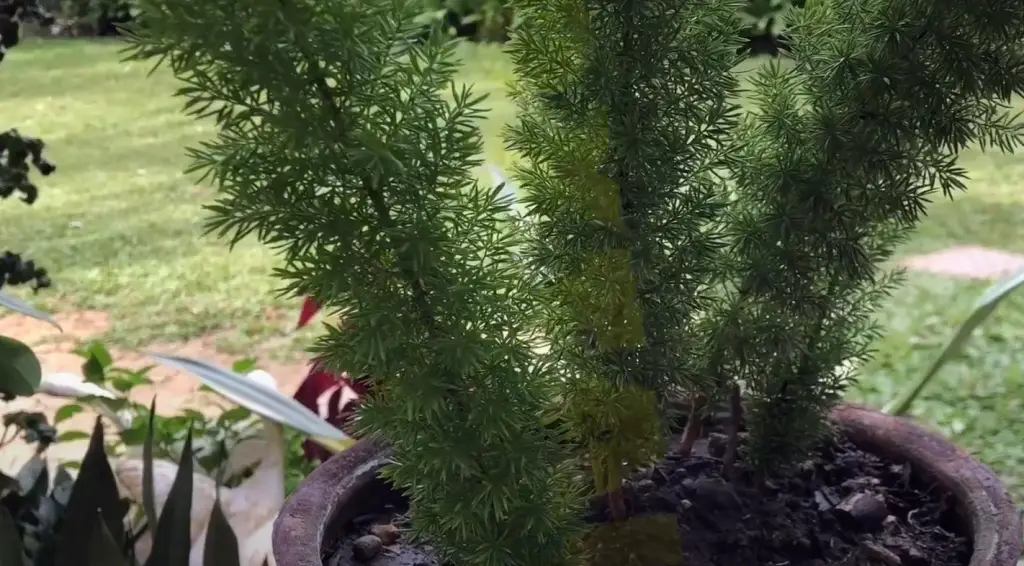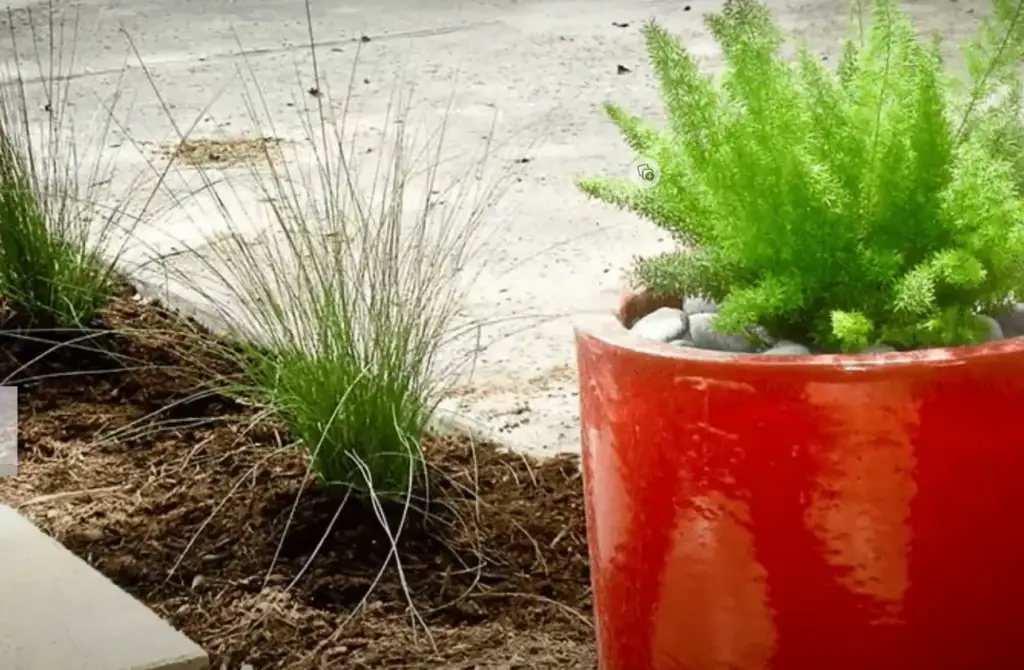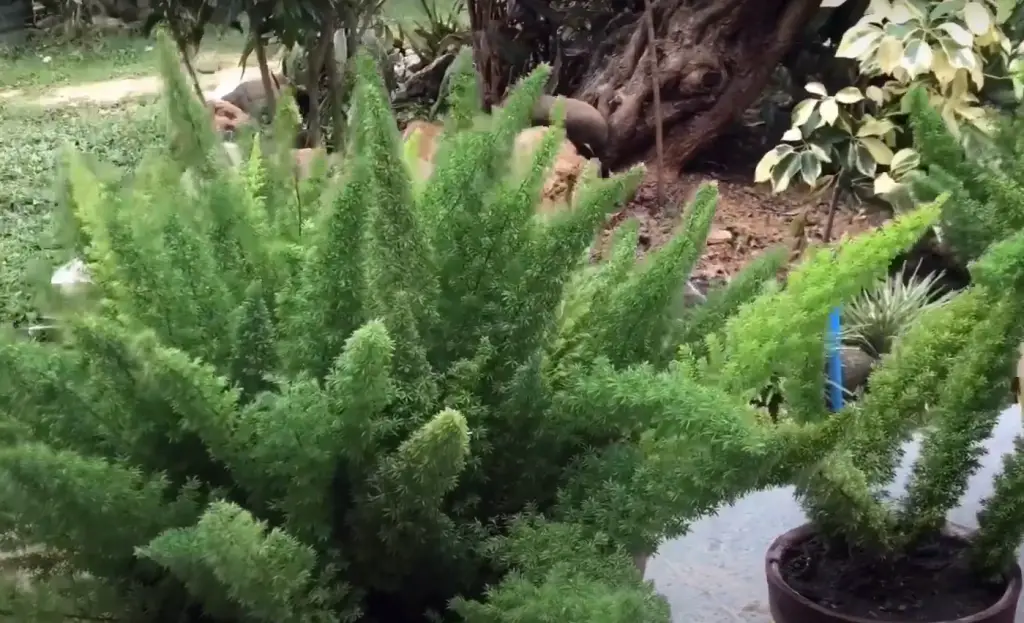Have you been looking for creative and inspiring ways to transform your outdoor space? Look no further! Foxtail Fern Landscaping Ideas provide a unique and attractive landscape design that can give any backyard a lush, verdant look. By using these helpful and informative tips, you can create a visually stunning display and add an extra layer of beauty to your home. With our guide on Foxtail Fern Landscaping Ideas, you’ll be able to take advantage of this distinctive plant’s unique characteristics and make your outdoor paradise something truly special.
Foxtail Fern Origin and Sun Tolerance
The Foxtail fern originates from Africa, Southeast Asia and Australia. It thrives in full sun but also tolerates partial shade. In more temperate areas of the world, it can be planted outside year-round; however, in colder climates it will need to be taken indoors during winter months. Since they are drought tolerant plants, they require minimal water and don’t require a lot of maintenance or caretaking.

Foxtail ferns make great additions to any landscape for a number of reasons:
- They are beautiful evergreen plants that provide lush greenery all year round.
- They come in various sizes and shapes so you can create different looks or textures in your garden.
- Because they are drought tolerant, they require minimal water and won’t need to be watered every day.
- They provide a great habitat for beneficial wildlife like birds, bees and butterflies.
- They have an upright form that makes them perfect for screening or borders between gardens or other outdoor areas.
Foxtail Ferns May Choke Out Nearby Plants
When planting Foxtail Ferns in your garden, be aware that they can sometimes grow quite aggressively, and spread very quickly. This means that you’ll need to make sure that the plants are spaced out accordingly, or even consider adding a barrier to prevent them from taking over nearby plants.
Without proper monitoring and maintenance, Foxtail Ferns could take over your whole garden!To ensure that your Foxtail Ferns remain healthy and don’t take over the garden, be sure to prune them regularly. You can also use a ground cover or mulching material around the ferns to help keep weeds away – this will provide some protection for other plants in your garden as well. Finally, if you find that Foxtail Ferns have started to spread too quickly, you may need to dig them up and transplant them in another area of your garden.
How to Care for a Foxtail Fern
Foxtail ferns are a type of ornamental plant that grows well in many different climates. They make excellent additions to any garden and are relatively easy to care for.

Here are some tips to help you keep your foxtail fern looking its best:
- Water regularly, but don’t overwater – it will cause root rot. Foxtail ferns prefer moist soil, so water thoroughly when the soil starts feeling dry.
- Prune back old fronds to encourage new growth and maintain a neat look.
- Feed with a balanced fertilizer once or twice per year, making sure not to overfeed as this could burn the roots.
- Place the foxtail fern in an area with indirect sunlight and good air circulation.
- Make sure to check for pests such as aphids, mealybugs, and spider mites on a regular basis. If you find any, treat them quickly before they spread further into your garden.
With just a bit of care and attention to detail, you can have a beautiful foxtail fern that will bring joy to your garden for years to come!
USDA Hardiness Zone
The foxtail fern is hardy in zones 5 to 11, depending on the variety. It enjoys temperatures of between 65 to 75 degrees Fahrenheit and can stand up to some cold weather with a bit of protection. When planting the foxtail fern outdoors you should keep it away from strong winds that could damage the foliage.
Size
Foxtail ferns are relatively small plants, growing to just 2 or 3 feet tall. When planting the foxtail ferns in your garden, make sure you give them enough room to grow without cramming a bunch of other plants around them. If you have a larger area that needs filling, plant several clusters of foxtails for a full look.

Foxtail ferns do well when planted in containers as well if you don’t have space for an outdoor bed.
Foxtail Fern Light Requirements
Foxtail ferns love light, but too much of it can damage the plants. If you put outdoor foxtail ferns in direct sunlight for more than a few hours per day, the leaves will start to scorch and turn brown. Moreover, if your foxtail fern receives excessive amounts of sun, the soil may become dry and dusty, worsening its health even further.
To avoid this problem, place your foxtail fern in a location that gets bright indirect light or partial shade throughout most of the day. This allows the plant to take in just enough sunlight while avoiding burnout from long exposure to direct sunlight. Additionally, when planting foxtail ferns outdoors, try to locate them in north-facing areas where they will be safe from too much sun.
Finally, when growing a foxtail fern indoors, place it near a bright window that gets at least a few hours of direct sunlight each day. Keep an eye on how the plant is doing and adjust the light accordingly if necessary. With enough light, your foxtail fern should stay healthy and look beautiful year round!
Foxtail Fern Water Requirements
Foxtail Ferns are a low-maintenance, drought-tolerant ornamental plant that requires very little water once established. Because they grow in dense clusters, however, it is important to water them deeply and regularly during their first growing season. To do this, simply set up an irrigation system with drip emitters or soaker hoses around the base of your Foxtail Ferns. Water them thoroughly two to three times per week for the first few weeks after planting.
During periods of extreme heat or drought, increase watering frequency to make sure your Foxtail Ferns don’t dry out too much. Just make sure to avoid over-watering, as this can cause root rot and other problems. With the right watering regimen, your Foxtail Ferns will thrive and bring a lush, tropical feel to your landscape! Happy gardening!Foxtail Fern Soil
Foxtail ferns need well-draining soil, preferably with a pH of 6.5–7.0. If your soil is too acidic, you can add lime to make it more alkaline. Additionally, they should be planted in areas with partial sun and shade as they can become scorched in direct sunlight. Keep the soil moist but not wet – water weekly or biweekly depending on how dry it gets during the summer months.

Be sure to avoid over-watering as this will lead to root rot and fungal diseases which may kill the plant entirely if left unchecked. Finally, use fertilizer sparingly as these plants do not require much in terms of added nutrients for growth and health. A general purpose fertilizer should be sufficient. Do not use a nitrogen-rich fertilizer as this can lead to too much growth and possible damage.
Foxtail Fern Repotting/Transplanting
When it comes to repotting or transplanting your foxtail ferns, there are a few things to bear in mind. First, never repot the plant without gently loosening the soil at the bottom of the pot. Next, use well-draining potting soil and make sure that you don’t pack it too tight. Finally, give your transplanted foxtail fern plenty of water and make sure to place it in an area with partial shade or indirect sunlight. With proper care and maintenance, your foxtail fern will thrive!
Fertilizer
When it comes to foxtail ferns, you don’t need to worry about watering them a lot. They can survive with only moderate watering as long as the soil remains moist but not soggy.
Fertilizing your foxtail fern is also important for its healthy growth. Feed the plant once every 2 weeks during spring and summer using a balanced liquid fertilizer diluted to half strength. During winter months, you can reduce feeding frequency or use an all-purpose slow-release fertilizer instead.
Pruning
Foxtail ferns require regular pruning to keep them tidy and looking their best. Prune off any dead or damaged fronds as soon as you spot them, and trim the entire plant back if it becomes overgrown. Use a pair of sharp garden shears for this task. When pruning, take care not to cut into the center of the plant, as this could damage the stem and decrease its healthiness. For regular maintenance, lightly trim the outer edges of your Foxtail fern once every couple of months during warm weather – this will help ensure that your plant looks its best!
Foxtail Fern Propagation
If you want to propagate or spread your Foxtail Fern further throughout your landscape, there are a few methods you can use. You can divide the plant by cutting it into pieces and replanting each piece with soil. Alternatively, you can take cuttings from the fern’s fronds, dip them in rooting hormone, and stick them in well-draining potting soil.

This method works best in spring or summer when the fern is actively growing. Finally, if these two methods don’t work for you, try propagating using spores that form under the fronds of female ferns. To do this, collect the spores and spread them in damp soil where they will grow new plants over time.
Foxtail Fern Flowers
Foxtail ferns are popular for their cascading leaves that resemble an animal’s tail. They can bring a unique, whimsical look to your garden or landscape. While these plants don’t technically produce flowers, the soft-green foliage works well with other brightly colored blooms to provide a beautiful display of texture and color in your yard. Additionally, the foxtail plant is low-maintenance and can withstand a variety of conditions, making it an easy choice for any landscaping project.
Pest
Foxtail ferns are generally quite resistant to pests, but there are some that can cause problems for your plants. To ensure the health of your foxtail ferns, keep an eye out for aphids, mealybugs, scales, and spider mites. If you spot any of these pests on your plants, treat them promptly with insecticidal soap or horticultural oil. Also be sure to clean up fallen leaves and debris from around the plant so as to not attract any further insects. In addition to pest control, it’s also important to regularly fertilize your foxtail ferns in order to promote healthy growth and prevent nutrient deficiencies. A balanced fertilizer with a slow-release formula is the best option for foxtail ferns. [1]
Foxtail Fern Leaves Turning Yellow
If you’re caring for your Foxtail fern and noticed some of the leaves turning yellow, don’t worry—it’s totally normal! It could be a sign of over-watering (too much water can cause root rot) or it could just mean that your plant is getting older. Either way, it’s important to take action to ensure the health of your Foxtail fern.
To start, check the soil around the roots of your Foxtail fern. Is it too wet? If so, try adjusting your watering schedule. You should also make sure there’s proper drainage to avoid root rot. Additionally, make sure you’re not overwatering as this can lead to yellow leaves.
If the soil looks dry, it may be time to give your Foxtail fern a little extra TLC. Check the light levels in its area and make sure it’s getting enough sunlight or shade, depending on what works for the species. Additionally, if you’ve recently moved your Foxtail fern to a different location, consider adjusting its nutrients as well.
Finally, try not to worry too much about yellowing leaves! It’s very normal for Foxtail ferns and other plants to go through changes like this throughout their life cycles, so don’t start panicking just yet!
How To Care For A Foxtail Fern In Winter
Winter can be a challenge when it comes to caring for a Foxtail Fern. To protect your plant in winter, here’s what you should do:
- Move the pot indoors if there is any chance of frost. Foxtail ferns are not frost tolerant and even temperatures below 32 degrees Fahrenheit (0 C) could cause irreparable damage to the foliage.
- Provide bright but indirect light while the plant is indoors. This will help keep it from becoming leggy or weak over time.
- Cut down watering significantly during the winter months but make sure the soil doesn’t dry out completely as this could cause root rot or other issues.
- If possible, mist the foliage often to provide the necessary humidity. However, be careful not to overwater as this could cause rot and fungal diseases.
- Keep an eye out for pests or diseases as these can worsen during the colder months. Make sure to take care of issues quickly if you notice any.

Following these tips will help keep your Foxtail Fern healthy even in winter! With a bit of patience and care, you’ll have a beautiful plant when spring arrives.
Foxtail Fern Uses
Foxtail ferns make excellent ground cover in beds and around trees, as they are evergreen and will remain lush green year-round. They can tolerate drought conditions and low light, so they’re a great option for areas of your garden that may not receive much sunlight. Additionally, their feathery foliage makes them a great choice for creative designs or borders.
If you have an area in need of extra greenery, but don’t want something too large like a tree or shrub, foxtail ferns are the perfect solution! They add texture and interest without taking up too much space. These plants are also low maintenance, so they’re the ideal choice for busy homeowners who don’t have a lot of time to devote to gardening.
Foxtail ferns can also be used in containers or hanging baskets as well. Their feathery foliage will cascade down over the sides of the container, making them an eye-catching addition to any outdoor space.
Foxtail Ferns In Containers
Foxtail ferns are the perfect addition to any space, indoors or outdoors. They’re hardy and come in a variety of sizes, making them ideal for growing in containers. To get started, choose a container that is large enough for your desired plant size and fill it with potting soil. Place the foxtail fern in the center of the container and make sure it’s not too deep or shallow—it should sit just above the rim of the pot. Water when necessary and place in an area with bright light but no direct sunlight. As your foxtail fern grows, you may need to periodically prune it back if it gets too large for its container. Foxtail ferns in containers also make great conversation pieces and can be placed on a patio, deck, balcony, or even indoors. With the right care and attention, your foxtail fern container garden will thrive for years to come!
Foxtail Fern Companion Plants
A great way to enhance your Foxtail Fern landscaping is by incorporating companion plants. Companion planting can help you create a more diverse, visually appealing garden and can also attract beneficial insects to the area. Some of the best companion plants for Foxtail Ferns include:
- Hosta
- Coleus
- Caladium
- Begonias
- Impatiens
- Japanese painted ferns
These companion plants provide a variety of shapes and colors, making them perfect for pairing with Foxtail ferns. When selecting companion plants, look for ones that have similar light and water requirements as the foxtails so they will thrive together in one space. With careful selection and planting, you can create a stunning garden oasis with Foxtail Ferns at the center.
Foxtail Fern Indoors
Foxtail ferns can also be grown indoors, but they need a lot of humidity and bright indirect sunlight. To keep your foxtail fern happy indoors, place it in a bathroom or kitchen where there is plenty of moisture in the air. If possible, you may want to mist the leaves once a week with a spray bottle that has been filled with distilled water; this will help to simulate natural rainwater and provide additional hydration. Additionally, you should avoid placing your foxtail fern near any sources of artificial heat, as this could quickly dry out the plant’s foliage and lead to wilting.

Finally, make sure that your foxtail fern gets enough light by placing it next to an east-facing window. With the right level of humidity and sunlight, your foxtail fern can bring a unique look to any indoor space.
Foxtail Fern Outdoors
Foxtail ferns are highly adaptable plants that can grow in various types of soil, including sandy or clay soils, as long as they have a well-draining foundation. It is important to note that these plants need at least five hours per day of direct sunlight, so if you plan on planting them outdoors it is best to place them somewhere open where they can receive plenty of light throughout the day. Additionally, be sure to water your foxtail ferns regularly during their growing season; this will help ensure that the plant has enough hydration and can thrive. When planted outdoors, foxtail ferns can be a great way to add texture and color to your garden or outdoor space.
Foxtail Ferns In Flower Arrangements
Foxtail ferns have a beautiful feathery texture and make an excellent addition to any flower arrangement. These plants are low-maintenance and can last up to two weeks in an arrangement, making them perfect for wedding bouquets or table centerpieces. To create the perfect foxtail fern flower arrangement, combine the ferns with other flowers of similar colors, such as dahlias or roses. For a unique look, you could also opt for bright-colored blooms like lilies or tulips to contrast against the lush greenery of the ferns. Just be sure to keep your arrangements out of direct sunlight to prevent fading and wilting. With proper care, these beautiful arrangements will stay looking elegant for days. [2]
FAQ
What goes well with foxtail fern?
Foxtail fern looks great with a variety of different plants and flowers, creating a lush and vibrant landscape. Try combining foxtail fern with low-growing shrubs such as lavender or blueberry bushes, which create colorful contrast and texture in your garden. You can also add pops of bright color using annuals like petunias, impatiens, and zinnias. For an even more dramatic look, consider pairing foxtail fern with tall grasses such as miscanthus or pampas grass. [3]
Do foxtail ferns like sun or shade?
Foxtail ferns thrive best in partial sun and shade. Too much direct sunlight can cause the leaves to scorch or burn, especially in hotter climates. If you live in an area where temperatures soar during the summer, it is best to provide your plants with some afternoon shade and only provide them with a few hours of the morning sun. Additionally, regular watering will help keep your foxtail ferns looking happy and full of life! [4]
Where should foxtail ferns be placed?
Foxtail ferns are a great way to bring texture and life to any garden or landscaping project. When deciding where to place them, think of how much light they will require. Foxtail ferns prefer partial shade, so try not to put them in an area that gets too much sun. They also need moist soil and regular watering during dry periods. Planting foxtail ferns near a house wall or fence can help protect the plants from wind damage, while providing some extra protection from direct sun rays. Once you have found the perfect spot for your foxtail ferns, it is time to focus on design placement. Grouping several together creates an interesting effect and helps bring out their unique texture. Try mixing them with other plants of different sizes and shapes to create a diverse landscape. Be sure to place taller plants in the back, and shorter ones in the front, and fill in any gaps between them with mulch or gravel. Finally, add a few accent pieces like stepping stones or garden art for an extra pop of color and interest. With some careful planning and creative placement, you can easily incorporate foxtail ferns into your landscaping project!
How do you make a foxtail fern bushy?
Foxtail ferns have a naturally compact form, but with certain conditions and regular trimming, you can make them even bushier. To create bushier foxtail ferns, be sure to provide adequate light, water and fertilizer. You should also regularly pinch back the stems of new growth to encourage branching out. By following these steps, your foxtail fern will soon take on a lush and bushy appearance! In addition to trimming the plants once they reach their desired size and shape and pruning away any dead or damaged foliage, it’s important to fertilize your foxtail fern every six months during its active growing season. This will give it the nutrients it needs for healthy growth. You should also make sure to water your foxtail fern regularly and provide it with bright, indirect sunlight throughout the day. [5]
Useful Video: 6 Best Foxtail Fern Landscaping Ideas
Conclusion
Foxtail ferns are a great addition to any outdoor space. They provide texture, interest, and color throughout the year with their bright green fronds. With proper care and maintenance, these hardy plants can be an attractive focal point in a landscape for years to come. With some creativity, you can use foxtail ferns in many different ways–from groundcovers to tall hedges–to create the perfect outdoor retreat. So go ahead and start planning your own foxtail fern landscaping ideas today!
We hope this guide has given you plenty of food for thought and inspiration when it comes to using foxtail ferns in your landscaping projects. Give them a try – we think you’ll be glad you did! Thanks for reading and happy gardening.
References:
- https://dengarden.com/gardening/Beautiful-Foxtail-Fern-has-a-Dark-Side
- https://www.joyusgarden.com/an-easy-care-fun-fern-myers-or-foxtail-fern/
- https://dengarden.com/gardening/foxtail_fern
- https://horticultureunlimited.com/plant-guide/foxtail-fern/
- https://www.thespruce.com/growing-foxtail-ferns-5094101










Leave a Reply
View Comments